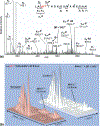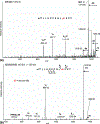A novel serine phosphorylation site detected in the N-terminal domain of estrogen receptor isolated from human breast cancer cells
- PMID: 18367407
- PMCID: PMC7456516
- DOI: 10.1016/j.jasms.2008.02.008
A novel serine phosphorylation site detected in the N-terminal domain of estrogen receptor isolated from human breast cancer cells
Abstract
Activated estrogen receptor (ERalpha) plays a critical role in breast cancer development and is a major target for drug treatment. Serine phosphorylation within the N-terminal domain (NTD) contributes to ERalpha activation and may also cause drug resistance. Previous biochemical identification of phosphorylated ERalpha residues was limited to protein artificially overexpressed in transfected cell lines. We report mass spectrometric methods that have allowed the identification of a new site within the NTD of ERalpha isolated from cultured human breast cancer cells. Immunoprecipitation, trypsin digestion, and analysis by nano-LC-ESI-MS/MS (Q-STAR, MDS Sciex) and vMALDI-MS(n) (Finnigan LTQ, Thermo-Electron) identified peptides containing 8 of 14 serine residues within the NTD, one being partially phosphorylated Ser-167, known but not previously reported by MS. Chymotrypsin digestion revealed other known sites at Ser-102/104/106 and 118. Tandem methods developed for the peptide containing Ser-118 and the use of hypothesis-driven experiments--i.e., the assumption that an intact phosphopeptide showing no molecular ion might yield fragment ions including loss of phosphoric acid in vMALDI-MS/MS--allowed the identification of a novel site at Ser-154. Quantitation by selected reaction monitoring demonstrated 6-fold and 2.5-fold increases in Ser-154 phosphorylation in estradiol- and EGF-treated cells, respectively, compared to controls, confirmed by immunoblotting with a novel rabbit polyclonal antibody. Thus, the protein isolation and MS strategies described here can facilitate discovery of novel phosphorylation sites within low abundance, clinically important cancer targets like ERalpha, and may thereby contribute to our understanding of the role of phosphorylation in the development of breast cancer.
Conflict of interest statement
The authors declare no conflict of interest.
Figures






Similar articles
-
Identification of in vivo phosphorylation sites on human deoxycytidine kinase. Role of Ser-74 in the control of enzyme activity.J Biol Chem. 2006 Feb 24;281(8):4887-93. doi: 10.1074/jbc.M512129200. Epub 2005 Dec 16. J Biol Chem. 2006. PMID: 16361699
-
Glycogen synthase kinase-3 interacts with and phosphorylates estrogen receptor alpha and is involved in the regulation of receptor activity.J Biol Chem. 2005 Sep 23;280(38):33006-14. doi: 10.1074/jbc.M506758200. Epub 2005 Aug 1. J Biol Chem. 2005. PMID: 16076840
-
Identification of four novel phosphorylation sites in estrogen receptor alpha: impact on receptor-dependent gene expression and phosphorylation by protein kinase CK2.BMC Biochem. 2009 Dec 31;10:36. doi: 10.1186/1471-2091-10-36. BMC Biochem. 2009. PMID: 20043841 Free PMC article.
-
Estrogen receptor alpha phosphorylation and its functional impact in human breast cancer.Mol Cell Endocrinol. 2015 Dec 15;418 Pt 3:264-72. doi: 10.1016/j.mce.2015.01.016. Epub 2015 Jan 15. Mol Cell Endocrinol. 2015. PMID: 25597633 Review.
-
Potential role of estrogen receptor alpha (ERalpha) phosphorylated at Serine118 in human breast cancer in vivo.J Steroid Biochem Mol Biol. 2006 Dec;102(1-5):139-46. doi: 10.1016/j.jsbmb.2006.09.021. Epub 2006 Nov 7. J Steroid Biochem Mol Biol. 2006. PMID: 17092701 Review.
Cited by
-
Elevated expression of TANK-binding kinase 1 enhances tamoxifen resistance in breast cancer.Proc Natl Acad Sci U S A. 2014 Feb 4;111(5):E601-10. doi: 10.1073/pnas.1316255111. Epub 2014 Jan 21. Proc Natl Acad Sci U S A. 2014. PMID: 24449872 Free PMC article.
-
Quantification of Breast Cancer Protein Biomarkers at Different Expression Levels in Human Tumors.Methods Mol Biol. 2018;1788:251-268. doi: 10.1007/7651_2017_113. Methods Mol Biol. 2018. PMID: 29243084 Free PMC article.
-
Quantitative proteomics of breast tumors: Tissue quality assessment to clinical biomarkers.Proteomics. 2017 Mar;17(6):10.1002/pmic.201600335. doi: 10.1002/pmic.201600335. Proteomics. 2017. PMID: 28127872 Free PMC article.
-
Assay development for the determination of phosphorylation stoichiometry using multiple reaction monitoring methods with and without phosphatase treatment: application to breast cancer signaling pathways.Anal Chem. 2010 Jul 1;82(13):5610-20. doi: 10.1021/ac1005553. Anal Chem. 2010. PMID: 20524616 Free PMC article.
-
Systematic mapping of posttranslational modifications in human estrogen receptor-alpha with emphasis on novel phosphorylation sites.Mol Cell Proteomics. 2009 Mar;8(3):467-80. doi: 10.1074/mcp.M800282-MCP200. Epub 2008 Nov 3. Mol Cell Proteomics. 2009. PMID: 18984578 Free PMC article.
References
-
- Joel PB; Traish AM; Lannigan DA Estradiol-Induced Phosphorylation of Serine 118 in the Estrogen Receptor Is Independent of p42/p44 Mitogen-Activated Protein Kinase. J. Biol. Chem 1998, 273, 13317–13323. - PubMed
-
- Likhite VS; Stossi F; Kim K; Katzenellenbogen BS; Katzenellenbogen JA Kinase-Specific Phosphorylation of the Estrogen Receptor Changes Receptor Interactions with Ligand, Deoxyribonucleic Acid, and Coregulators Associated with Alterations in Estrogen and Tamoxifen Activity. Mol. Endocrinol 2006, 20, 3120–3132. - PubMed
-
- McInerney EM; Katzenellenbogen BS Different Regions in Activation Function-1 of the Human Estrogen Receptor Required for Antiestrogen- and Estradiol-dependent Transcription Activation. J. Biol. Chem 1996, 271, 24172–24178. - PubMed
-
- Jensen EV; Jordan VC The Estrogen Receptor: A Model for Molecular Medicine. Clin. Cancer Res 2003, 9, 1980–1989. - PubMed
-
- Shiau AK; Barstad D; Loria PM; Cheng L; Kushner PJ; Agard DA; Greene GL The Structural Basis of Estrogen Receptor/ Coactivator Recognition and the Antagonism of This Interaction by Tamoxifen. Cell 1998, 95, 927–937. - PubMed
Publication types
MeSH terms
Substances
Grants and funding
LinkOut - more resources
Full Text Sources
Other Literature Sources
Medical
Molecular Biology Databases
Research Materials
Miscellaneous

